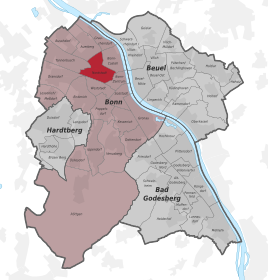Nordstadt (Bonn)
|
North city
Federal city of Bonn
Coordinates: 50 ° 44 ′ 35 ″ N , 7 ° 5 ′ 10 ″ E
|
|
|---|---|
| Height : | 58 m above sea level NHN |
| Residents : | 16,435 (Dec. 31, 2018) |
| Postcodes : | 53111, 53117, 53119 |
| Area code : | 0228 |
|
Location of the district of Nordstadt in the Bonn district
|
|
The Nordstadt is a district of the federal city of Bonn in the city district of the same name . It is located northwest of the center and has about 16,000 inhabitants.
The district corresponds roughly to the statistical districts of Ellerviertel and Vor dem Sterntor .
History and building structure
Today's northern city was built around the same time as the southern city . In contrast to the more scenic Südstadt, however, the northern expansion of the city developed into a residential area for the lower middle class . Former " corridors " functioned as the main access axes , u. a. the Breite Strasse and the Heerstrasse. Adolfstrasse was opened up in the 1870s - as a parallel to Heerstrasse. After the construction work was largely unplanned until the 1890s, the Stiftsgasse, which was built between 1891 and 1899, was based on more extensive plans for the first time. Kasernenstrasse and the streets starting from Kaiser-Karl-Ring, built in 1910 and laid out in the years 1893–1898, were also based on more detailed designs. To the northeast, Kölnstrasse formed the boundary of the city's expansion.
The residential buildings of the resulting district were also used commercially in the basement or in extensions. The different equipment of the predominantly three-axle and three-storey houses is based on the different wishes of the users. In contrast to Südstadt, balconies and front gardens were not set up.
From 1973 to 1977 the new Bonn town hall was built on the southern edge of the district , and the associated demolition of several streets led to protests. Since 1975 the northern part of the city has been completely renovated as part of urban renewal measures; the entire quarter has been a listed building since 1990.
Old town
The southern part of Nordstadt (Innere Nordstadt) is characterized by old houses and narrow, winding streets. It has therefore been known as the old town since the mid-1970s . The inner northern part of the city was already a popular pub district, especially among students and schoolchildren. At that time, several innkeepers and business people came together to form the old town initiative . The pubs involved received signs saying "Old Town - the heart of Bonn". The expression old town was based on the model of Düsseldorf's old town , which at that time already had a legendary reputation as a pub district. In fact, the Innere Nordstadt is not in the area of Bonn's historic old town. This, also called de Kuhl , was rather between the market, town hall and the banks of the Rhine and extended in the north to Stiftsplatz in the immediate vicinity of the northern part of the city. Bonn's historic old town was badly hit by air raids during World War II. Unpopular as a residential area and of little prestige, it was largely demolished in the 1950s and built over with new buildings in the style of the 50s, 60s and 70s. In the Brüdergasse, an inscription with a stylized city map reminds us of this "old town redistribution". The term old town fell out of use in Bonn; Because it had thus become “free”, the Nordstadt hosts were able to transfer it to the area between Breite Strasse and Heerstrasse around 1975, and the New Old Town was created. The local businesspeople hold on to this practice to this day and have attached a "Altstadt" label spanning Breite Straße.
Landmarks and modern usage
In the area between the former market halls and the Potsdamer Platz distribution circle ( junction and end point of the A 555 ) is the distribution circle industrial area . In addition to the eggnog manufacturer Verpoorten , and Magnetfabrik Bonn have there some car dealers , drive-in restaurants , and a discounter located.
To the east of Potsdamer Platz was the no longer used Poststadion , in which there was a cycling track .
At the southern end of the northern part of the city, next to the town hall, there is the Old Cemetery , which was laid out in 1715, with the graves of Ernst Moritz Arndt , Clara and Robert Schumann , Karl Joseph Simrock , Wilhelm Schmidtbonn and other famous Bonners. Opposite the listed Frankenbad , one of Bonn's four indoor swimming pools , on the Hochstadenring, are the Bonn Art Association and the Bonn Artists' Forum . In the art library there, there is the possibility of borrowing contemporary art .
The city church of St. Marien , located on Adolfstrasse at the corner of Oppenhoffstrasse, is one of the most important and stylish churches in Bonn city center. The neo-Gothic Catholic church was built from 1887 to 1892. A newer Catholic church building from the 1960s is St. Franziskus .
The August-Macke-Haus is located directly on the Viktoriabrücke . There are exhibitions about the artist in the house. Another museum is the Women's Museum in the north of the city.
The Ludwig Erhard Vocational College for Economics and Administration is also located in the north of the city .
See also
Individual evidence
- ↑ Population in Bonn by districts (according to the main statute) on December 31 , 2018 , Federal City of Bonn - Statistics Office, February 2019
- ^ Andreas Denk, Ingeborg Flagge : Architekturführer Bonn . Dietrich Reimer Verlag, Berlin 1996, ISBN 3-496-01150-5 , p. 57.





